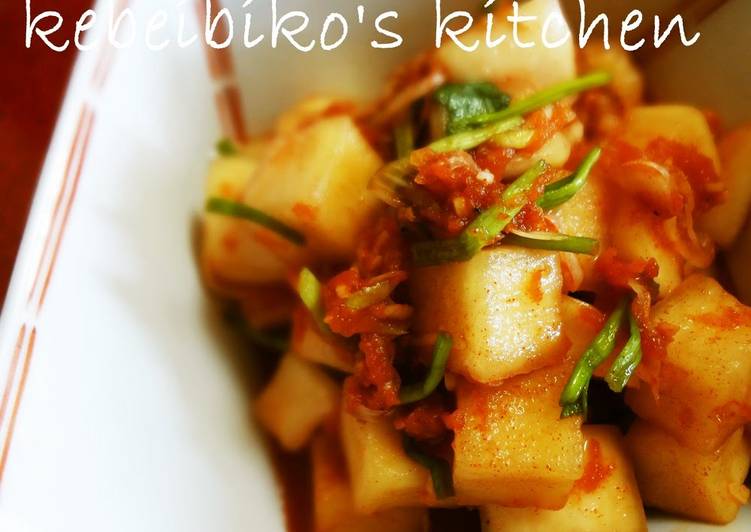Kkakdugi (Cubed Radish Kimchi). Daikon radish, fish sauce, garlic, ginger, green onion, hot pepper flakes, korean radish, salt, sugar. Korean radish (mu or muwoo in Korean) or daikon is used to make this kimchi. Ingredients: Korean radish (or daikon), salt, sugar, fish sauce, hot pepper Put the kkakdugi into a glass jar and press down on the top of it to remove any air from between the radish cubes.
 It's an easy kimchi to make!
Simply cut the radishes into cubes, salt for a short time The name kkakdugi comes from how the radish is cut — cubed, and it's known as cubed radish kimchi in English.
This recipe was originally posted in Nov.
You can have Kkakdugi (Cubed Radish Kimchi) using 12 ingredients and 13 steps. Here is how you cook that.
It's an easy kimchi to make!
Simply cut the radishes into cubes, salt for a short time The name kkakdugi comes from how the radish is cut — cubed, and it's known as cubed radish kimchi in English.
This recipe was originally posted in Nov.
You can have Kkakdugi (Cubed Radish Kimchi) using 12 ingredients and 13 steps. Here is how you cook that.
Ingredients of Kkakdugi (Cubed Radish Kimchi)
- Prepare 1 large of Daikon radish.
- It's 2 tbsp of Salt.
- You need of For the sauce:.
- It's 1 of Apple.
- It's 2 tbsp of Korean chili (finely powdered).
- Prepare 3 tbsp of Fermented krill (saeujeot) (or fish sauce).
- It's 1 clove of Finely chopped garlic.
- It's 1 tsp of Minced ginger.
- You need 1 of Japanese leek (white part).
- You need 2 tbsp of Sugar.
- It's 1/2 tbsp of Salt.
- Prepare 1/2 bunch of Chinese celery (or garlic chives).
Kkakdugi (깍두기) or diced radish kimchi is a variety of kimchi in Korean cuisine. Usually, it has all the ingredients of kimchi, but the baechu (hangul: 배추; Napa cabbage) used for kimchi is replaced with Korean radish (called mu, 무 in Korean). Kkakdugi - Korean Cubed Radish Kimchi. So, if you have never made The size of the radish cubes for Kkakdugi comes in all different sizes.
Kkakdugi (Cubed Radish Kimchi) step by step
- [Prep the daikon radish] Peel the daikon radish and cut into 2 cm cubes. Put in a plastic bag and mix evenly with 2 tablespoons of salt. Let sit for 1 to 2 hours. The daikon radish will release a lot of water....
- Occasionally rub the daikon from outside the bag. Thoroughly drain the daikon in a colander (let sit for about 30 minutes. In Step 4 photo, you can see that 350 ml of water drained from the daikon on the left-hand side)..
- [Prepping the sauce] Grate the apple. Cut the Japanese leek in half lengthways first and slice thinly and diagonally. Cut the Chinese celery into 3 cm widths. Put all the sauce ingredients into a bowl and combine..
- After the red colour from the chill is evenly distributed, add the daikon. Stir well (if your skin is sensitive, use gloves)..
- Pour the mixture into a storage container and chill in the fridge. You can eat it the following day. After 1 week to 10 days, the flavour will become well rounded. It will not be tart..
- This photo shows two day-old kkakduki..
- [Korean powdered chili] You can keep leftovers in the fridge to prevent discolouring..
- [Fermented krill] You can buy bottled ones at the supermarket and freeze leftovers..
- You can cook various dishes with it..
- "Stir-fried Potato with Fermented Krill" https://cookpad.com/us/recipes/145848-potato-fermented-krill-stir-fry.
- "Pale Pink Edamame Bean Rice with Fermented Krill" https://cookpad.com/us/recipes/145337-pink-tinged-fermented-krill-edamame-rice.
- "Pasta Aglio e Elio with Nanohana and Fermented Krill" https://cookpad.com/us/recipes/153061-spaghetti-aglio-e-olio-with-nanohana-and-fermented-krill.
- "Kimchi Hot Pot Sundubu Jjigae-style".
Who can resist the crunch, refreshing, and perfectly fermented Korean radish kimchi called "Kkakdugi"? One Korean food that I am dying to eat right now is a bowl of hot bone marrow soup (설렁탕, seolleongtang) and. Crunchy cubes of korean radish pickled in a spicy mixture of chili flakes, scallions, ginger and salted brine shrimp. Kkakdugi is a popular kimchi paired with Kimchi comes in all shapes and sizes, but this Kkakdugi (깍두기) made with large Korean radish is a perennial favorite. Kkakdugi is Korean cubed radish kimchi made with daikon.